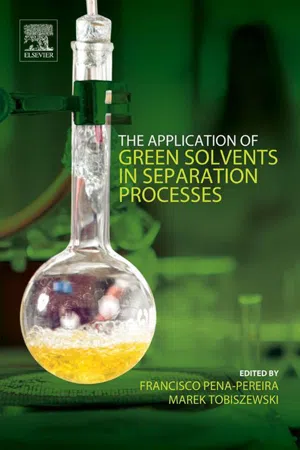
The Application of Green Solvents in Separation Processes
- 560 pages
- English
- ePUB (mobile friendly)
- Available on iOS & Android
The Application of Green Solvents in Separation Processes
About This Book
The Application of Green Solvents in Separation Processes features a logical progression of a wide range of topics and methods, beginning with an overview of green solvents, covering everything from water and organic solvents, to ionic liquids, switchable solvents, eutectic mixtures, supercritical fluids, gas-expanded solvents, and more.
In addition, the book outlines green extraction techniques, such as green membrane extraction, ultrasound-assisted extraction, and surfactant-mediated extraction techniques. Green sampling and sample preparation techniques are then explored, followed by green analytical separations, including green gas and liquid capillary chromatography, counter current chromatography, supercritical fluid chromatography, capillary electrophoresis, and other electrical separations.
Applications of green chemistry techniques that are relevant for a broad range of scientific and technological areas are covered, including the benefits and challenges associated with their application.
- Provides insights into recent advances in greener extraction and separation processes
- Gives an understanding of alternatives to harmful solvents commonly used in extraction and separation processes, as well as advanced techniques for such processes
- Written by a multidisciplinary group of internationally recognized scientists
Frequently asked questions
Information
Water as the First Choice Green Solvent
Abstract
Keywords
2.1 Introduction
2.1.1 Why to Use Water as a Solvent?
2.1.2 Water—The Most Green Choice
2.2 Solvent Properties of Water
Table of contents
- Cover image
- Title page
- Table of Contents
- Copyright
- List of Contributors
- Section I: Introduction
- Section II: Green Solvents
- Section III: Green Extraction Techniques
- Section IV: Green Sampling and Sample Preparation Techniques
- Section V: Green Analytical Separations
- Index